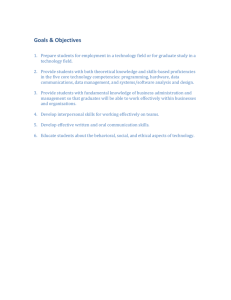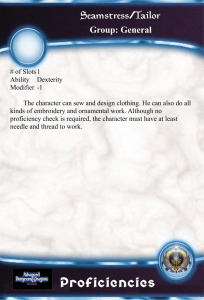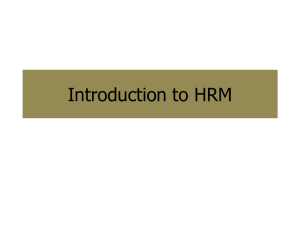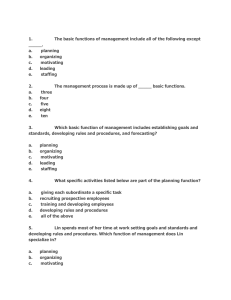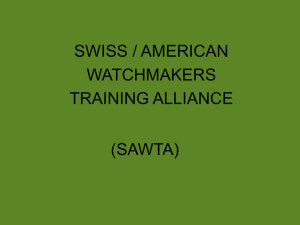Chapter 1 Introduction to Human Resource Management Human Resource Management
advertisement
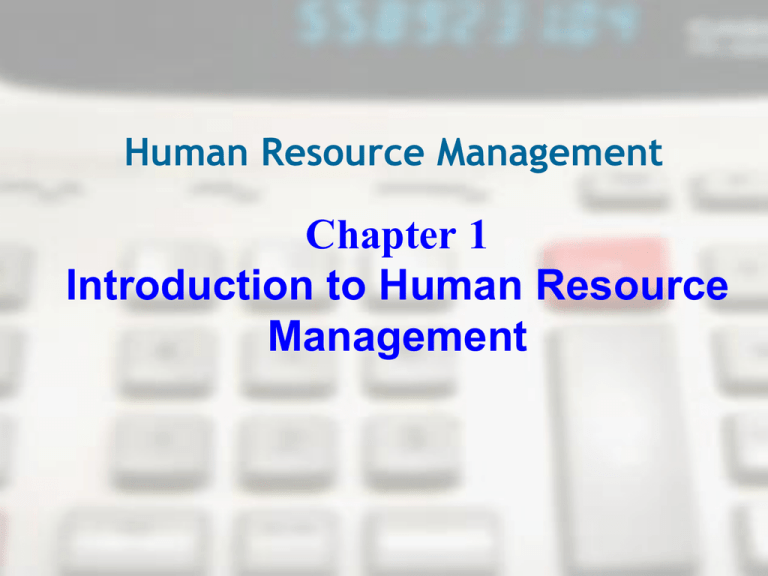
Human Resource Management Chapter 1 Introduction to Human Resource Management After studying this chapter, you should be able to: 1. Explain what human resource management is and how it relates to the management process. 2. Give at least eight examples of how all managers can use human resource management concepts and techniques. 3. Illustrate the human resources responsibilities of line and staff (HR) managers. 4. Provide a good example that illustrates HR’s role in formulating and executing company strategy. 5. Write a short essay that addresses the topic: Why metrics and measurement are crucial to today’s HR managers. 1–2 The Management Process Planning Controlling Leading Organizing Staffing 1–3 The Management Process The Management Process are Planning, Organizing, Staffing, Leading and Controlling 1. Management Process Planning Goals and standards Rules and procedures Plans and forecasting. 2. Organizing Tasks Departments Delegating Authority and communication Coordinating. 3. Management Process Staffing Hiring Recruiting Selecting Performance standards Compensation Evaluating performance Counseling Training and developing. 4. Management Process Leading Getting the job done Morale Motivation 5. Controlling Setting standards Comparing actual 1-4 performance to standards Corrective action HRM Function • Human Resource Management is the process of acquiring, training, appraising, and compensating employees and attending to their labor relations, health and safety, and fairness concerns. • Human Resource Management can be defined: • as the implementation of the strategies, plans and programs required to attract, motivate, develop, reward and retain the best people to meet the organizational goals and operational objectives of the organization. Human Resource Management at Work • What Is Human Resource Management (HRM)? – The policies and practices involved in carrying out the “people” or human resource aspects of a management position, including recruiting, screening, training, rewarding, and appraising. 1–6 Human Resource Management at Work Acquisition Training Fairness Health and Safety Labor Relations Human Resource Management (HRM) Appraisal Compensating 1–7 Personnel Aspects of a Manager’s Job • Conducting job analysis • Planning labor needs and recruiting job candidates • Selecting job candidates • Orienting and training new employees • Managing wages and salaries • Providing incentives and benefits • Appraising performance • Communicating • Training and developing managers • Building employee commitment 1–8 Basic HR Concepts • HR creates value by engaging in activities that produce the employee behaviors that the company needs to achieve its strategic goals. 1–9 Line and Staff Aspects of HRM • Line manager – A manager who is authorized to direct the work of subordinates and is responsible for accomplishing the organization’s tasks. • Staff manager – A manager who assists and advises line managers. 1–10 Line Managers’ HRM Responsibilities 1. Placing the right person on the right job 2. Starting new employees in the organization (orientation) 3. Training employees for jobs that are new to them 4. Improving the job performance of each person 5. Gaining creative cooperation and developing smooth working relationships 6. Interpreting the firm’s policies and procedures 7. Controlling labor costs 8. Developing the abilities of each person 9. Creating and maintaining department morale 10. Protecting employees’ health and physical condition 1–11 Human Resource Managers’ Duties Line Function Coordinative Function Functional Authority Line Authority Implied Authority Functions of HR Managers Staff Functions Staff Authority Innovator Employee Advocacy 1–12 Human Resource Specialties Recruiters Labor Relations Specialists Training Specialists Human Resource Specialties EEO Coordinators Job Analysts Compensation Managers 1–13 The Changing Environment of Human Resource Management Globalization Trends Changes and Trends in Human Resource Management Technological Trends Trends in the Nature of Work Workforce Demographic Trends 1–14 The Changing Environment of Human Resource Management : The Changing Environment of Human Resource Management 1.Globalization; tendency of firms to extend their sales and manufacturing to new markets abroad 2.Technological advances; technology has been forcing and enabling firms to become more competitive (skilled employee, empowerment) 3.The nature of work; Human capital(knowledge, education, training, skills and expertise of a firm’s worker) provides competitive advantage 4.The workforce diversity; increased diversity provide challenges for HR management 1-15 The Changing Role of Human Resource Management Strategic Human Resource Management Managing with the HR Scorecard Process New Responsibilities for HR Managers Creating HighPerformance Work Systems Measuring the HRM Team’s Performance 1–16 Technological Applications for HR Application Service Providers (ASPs) and technology outsourcing Web portals PCs and high-speed access Streaming desktop video The mobile Web and wireless net access E-procurement Internet- and network-monitoring software Bluetooth Electronic signatures Electronic bill presentment and payment Data warehouses and computerized analytical programs 1–17 Benefits of a High-Performance Work System (HPWS) 1. Generate more job applicants 2. Screen candidates more effectively 3. Provide more and better training 4. Link pay more explicitly to performance 5. Provide a safer work environment 6. Produce more qualified applicants per position 7. Hiring based on validated selection tests 8. Provide more hours of training for new employees 9. Conduct more performance appraisals 1–18 Measuring HR’s Contribution • The HR Scorecard 1. Shows the quantitative standards, or “metrics” the firm uses to measure HR activities. 2. Measures the employee behaviors resulting from these activities. 3. Measures the strategically relevant organizational outcomes of those employee behaviors. 1–19 The Human Resource Manager’s Proficiencies • New Proficiencies 1. HR proficiencies 2. Business proficiencies 3. Leadership proficiencies 4. Learning proficiencies 1–20 The Human Resource Manager’s Proficiencies (cont’d) • Managing within the Law 1. Equal employment laws 2. Occupational safety and health laws 3. Labor laws • Managing Ethics – Ethical lapses 1–21 The End End of Chapter 1 1-22

